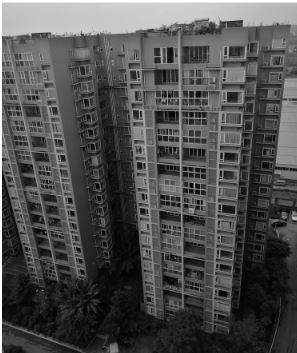Measurement and Simulation of Indoor Thermal Environment of Residential Building in Chengdu of China
Keywords:
Thermal insulation, Energy-saving measure, Energy-efficient design standardAbstract
To better understand the current situation of indoor thermal environment of residential buildings in Chengdu of China, a house located in one typical residential building which met the thermal insulation requirements of the 50% energy-efficient design standard was selected as the research object. Then its indoor thermal environment was measured and the information about occupants’ lifestyle was collected both in summer and in winter. The field-measured results showed the indoor thermal environment was poor. The mean indoor temperature in summer reached approximately 34.0 °C, while that in winter was only about 11.0°C and the relative humidity was often higher than 70%. Meanwhile, based on the information obtained from the survey, the indoor thermal environment of the case house was simulated by using DeST-h. The simulation results showed that the change trends of the simulated temperatures in the rooms of the case house in the typical days were close to those of the measured results. Finally, one conclusion could be drawn that the thermal insulation of envelope enclosure could not ensure a comfortable indoor thermal environment. Further, it revealed that perhaps such measures might not be good energy-efficient measures for the residential buildings in Chengdu.
Downloads
References
Changhai, P., Ling, W., & Xiaosong, Z. (2014). DeST-based dynamic simulation and energy efficiency retrofit analysis of commercial buildings in the hot summer/ cold winter zone of China: A case in Nanjing. Energy and Buildings, 78, 123-131.
Hui, M. (2010). Indoor thermal comfort in Chengdu area residential investigation and analysis research. Chengdu: Southwest Jiaotong University.
Lei, Z. (2017). Analysis of the factors affecting the energy consumption of residential buildings in Chengdu. Chengdu: Southwest Jiaotong University.
Ministry of housing and urban-rural development of China. (2010). Design standard for Energy Efficiency of residential buildings in hot summer and cold winter region. Beijing: China Architecture and Building Press.
Nianping, L., Yougui, P., & Yoshino, H. (2004). Field measurement and analysis of indoor thermal environment of Changsha Urban residential buildings. Building Energy and Environment, 23(1): 94-98.
Phillips J. L., Field, R., & Goldstone, M. (1993). Relationships between indoor and outdoor air quality in promising offices in United Kingdom. Atmospheric Environment, 27(11), 1743-1753.
Resource room of meteorological information center of meterological administration of China, Department of architectural technology and science of Tsinghua University. (2010). Special meteorological data set for building thermal environment analysis in China. Beijing: China Architecture and Building Press.
Rong, Q., Da, Y., & Xin, Z. (2012). Research on a dynamic simulation method of atrium thermal environment based on neural network. Building and Environment, 50, 214-220.
Shugui, D., Tan, Z., & Zhipeng, B. (1994). Viewpoints on enacting the standard of indoor air quality [J]. Urban Environment and Urban Ecology, 7(4), 36-39.
Tianjin eco-city green building research institute, Building energy conservation research center of Tsinghua University. (2014). Building energy simulation and operating tutorial of eQUEST and DeST. Beijing: China Architecture and Building Press.
Xiao, H. (2016). Assessment on building energy-saving status of new houses in Chengdu. Engineering Economics, 26(12), 69-72.
Xiaohang, F., Da, Y., & Tianzhen, H. (2015). Simulation of occupancy in buildings. Energy and Buildings, 87, 348–359.
Xiaoping, F., Baoguo, Q., & PengFei, Z. (2010). Measurement and analysis of indoor thermal environment of town house in Southern region of Jiangsu. Building Science, 26(4), 44-47.
Ya, F., Yanli, N., & Huizhi, Z. (2012). Energy efficiency and indoor thermal environment design of rural buildings in hot summer and cold winter zone. Building Science, 28(12):21-25.

Downloads
Published
How to Cite
Issue
Section
License

This work is licensed under a Creative Commons Attribution-NonCommercial-NoDerivatives 4.0 International License.










